Physical therapy assistant programs teach students how to use exercises and other treatments to improve patients’ physical health.
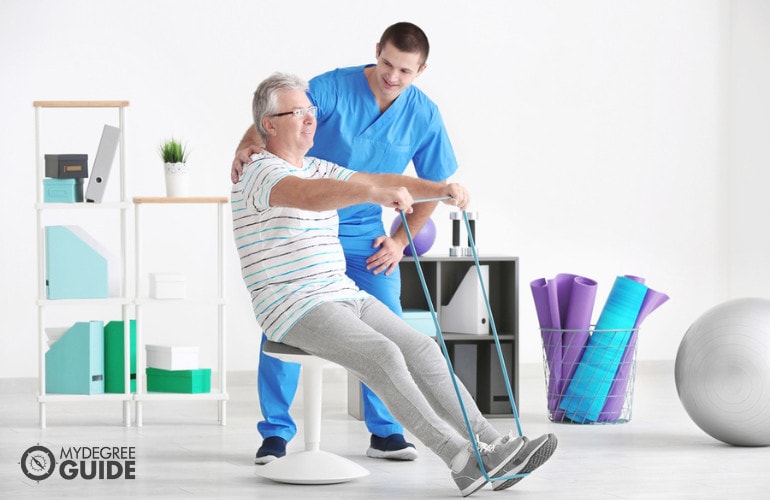
These programs cover a broad range of topics, such as anatomy and physiology, biomechanics, healthcare ethics, and kinesiology. Graduates who earn physical therapy certifications and degrees often become healthcare professionals in hospitals, nursing homes, and rehabilitation centers.
Editorial Listing ShortCode:
If you want to help people enhance their health and well-being, you may consider enrolling in an online physical therapist assistant program.
Universities Offering Online Physical Therapy Assistant Programs
Methodology: The following school list is in alphabetical order. To be included, a college or university must be regionally accredited and offer degree programs online or in a hybrid format.
1. Clark State College
Clark State College offers a Physical Therapy Assistant program. It requires a total of 65 credit hours, including a combination of online lectures and on-site labs. The curriculum is designed to prepare for Ohio’s licensure exam. Previous graduating classes have had a first-time pass rate of over 70% on the exam.
Clark State College is accredited by the Higher Learning Commission.
2. Delta College
Delta College’s Physical Therapy Assistant program typically takes 4 semesters to complete. A new cohort begins every fall. Students usually enroll full-time, taking at least 12 credit hours per semester. Most courses take place during the day. Some courses are available in fully online or blended formats. The program also requires the completion of 40 observation hours.
Delta College is accredited by the Higher Learning Commission.
3. Great Falls College MSU
Great Falls College MSU offers a Physical Therapy Assistant program. It offers fully on-campus and low-residency options. The low-residency option requires listening to pre-recorded lectures online on one’s own schedule and attending on-campus hands-on labs.
Great Falls College MSU is accredited by the Northwest Commission on Colleges and Universities.
4. Jefferson State Community College
Jefferson State Community College offers a Physical Therapist Assistant program that awards an Associate of Applied Science. All students are required to come to campus to complete lab sessions but have the option to listen to lectures online. Graduates of the program may take the National Board Exam to earn state licensure.
Jefferson State Community College is accredited by the Southern Association of Colleges and Schools Commission on Colleges.
5. Mendocino College
Mendocino College offers a hybrid Physical Therapist Assistant program that awards an Associate of Science. It can typically be completed in 5 semesters. It requires on-campus lab courses two days a week in fall and spring semesters. Graduates of the program may take the National Physical Therapy Exam to earn licensure.
Mendocino College is accredited by the Accrediting Commission for Community and Junior Colleges, Western Association of Schools and Colleges.
6. Midlands Technical College
Midlands Technical College offers a Physical Therapist Assistant program. It requires participation in hands-on labs and clinical experiences but has options to complete some courses online in synchronous or asynchronous formats. The program leads to an associate degree and eligibility to take the National Physical Therapist Assistant Licensing Board Exam.
Midlands Technical College is accredited by the Southern Association of Colleges and Schools Commission on Colleges.
7. Northwest Arkansas Community College
Northwest Arkansas Community College offers a Physical Therapist Assistant program that can be completed in traditional or hybrid formats. The hybrid format requires attendance on campus once every three or four weeks to participate in lab intensives. Graduates may take the National Physical Therapist Assistant Examination.
Northwest Arkansas Community College is accredited by the Higher Learning Commission.
8. Quincy College
Quincy College offers a Physical Therapist Assistant program. The curriculum is designed to develop both technical competence and critical thinking skills. Previous graduates have had a high pass rate on the NPTE-PTA licensure exam and high employment rates within six months of graduation.
Quincy College is accredited by The New England Commission of Higher Education.
9. Rasmussen University
Rasmussen University offers a Physical Therapist Assistant Associate. The program requires online coursework, on-campus immersive labs, and participation in field experiences at healthcare facilities. The program can potentially be finished in 18 months, and there are two different campus locations to choose from.
Rasmussen University is accredited by the Higher Learning Commission.
10. San Juan College
San Juan College has on-campus and online hybrid programs to become a physical therapist assistant. These programs award an Associate of Applied Science and offer opportunities to gain hands-on experience in state-of-the-art labs and real-world healthcare settings. They require the completion of 49 credits and usually take 5 semesters to finish.
San Juan College is accredited by the Higher Learning Commission.
Online Physical Therapy Assistant Programs

Physical therapy uses various treatments to help patients improve or regain their ability to perform functional movements, such as bending over and walking. These treatments reduce pain, enhance flexibility, and strengthen patients’ bones and muscles.
Physical therapy can benefit people with disabilities and patients recovering from an injury, illness, or surgery. Physical therapy assistants work under the supervision of licensed physical therapists. They use various exercises and stimuli to boost patients’ mobility and strength.
For instance, they may help a patient who fractured their humerus perform dumbbell exercises to rebuild their arm muscles. Other types of physical therapy include aerobic conditioning, massage, ultrasound, and warm water therapy.
Physical therapist assistant programs enable students to develop foundational healthcare knowledge and strong interpersonal skills. Courses typically cover subjects like these:
- Ethics
- Functional motor development
- Human anatomy and physiology
- Kinesiology
- Medical terminology
- Neurology
- Nutrition
- Orthopedics
- Pathology
- Therapeutic exercises
Additionally, physical therapy assistant programs require students to complete a series of clinical practicums. These experiences typically occur in local community health centers, hospitals, physical therapy clinics, and other sites. Students practice applying their skills with actual patients and receive mentorship from physical therapists.
Graduates from physical therapy assistant schools often go on to become licensed physical therapy assistants (PTAs). They aid physical therapists in various healthcare settings, including:
- Assisted living homes
- Fitness centers
- Home healthcare services
- Hospitals
- Rehabilitation facilities
- Schools
- Skilled nursing homes
- Sports medicine clinics
Some PTAs work as salaried employees for one company. Others become contract workers who travel between clinics, hospitals, and other organizations. Contract PTAs are in high demand and may work at one location for a few weeks or months.
The knowledge and skills learned in physical therapy assistant online programs could also apply to other entry-level healthcare jobs, such as:
- Home health aide
- Fitness trainer
- Medical sales representative
- Medical writer
- Occupational therapy aide
- Pharmacy technician
Some graduates use their PTA degrees as stepping stones to becoming licensed physical therapists. These professionals must complete a Doctor of Physical Therapy degree and pass a state licensure exam.
Physical Therapy Assistant Careers and Salaries
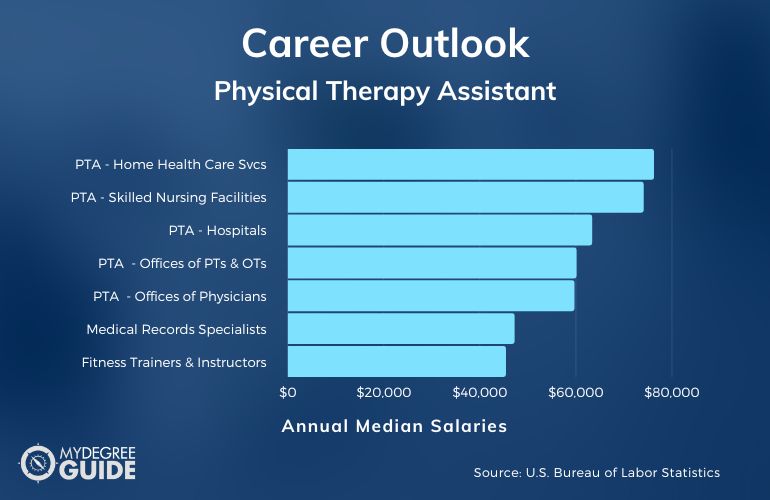
Graduates from physical therapy assistant programs online typically pursue careers in the healthcare industry. Most students become physical therapy assistants for medical and educational organizations.
For example, they may work for a public school system or a private physical therapy clinic. Physical therapy providers may specialize in one area, such as cardiovascular health, gerontology, oncology, orthopedics, pediatrics, women’s health, or wound management.
According to the Bureau of Labor Statistics, here are the median wages for careers related to physical therapy assistantship.
| Careers | Annual Median Salaries |
| Physical Therapist Assistants — Home Health Care Services | $76,210 |
| Physical Therapist Assistants — Skilled Nursing Facilities | $74,070 |
| Physical Therapist Assistants — Hospitals | $63,340 |
| Physical Therapist Assistants — Offices of PTs, OTs, SLPs, and Audiologists | $60,090 |
| Physical Therapist Assistants — Offices of Physicians | $59,650 |
| Medical Records Specialists | $47,180 |
| Fitness Trainers and Instructors | $45,380 |
| Recreation Workers | $31,680 |
| Physical Therapist Aides | $31,410 |
| Home Health and Personal Care Aides | $30,180 |
PTAs are in high demand. The Bureau of Labor Statistics anticipates that job openings for these professionals will increase by 26% over the next decade, which is much faster than the average for all careers.
Some graduates from PTA programs use their knowledge to secure positions outside of healthcare. For instance, students may work for corporations that develop mobility-assistance technology. A potential job title for these specialists is client success associate.
Current professionals also work in the fields of human resources, medical writing, recruiting, sales, and telework.
Physical Therapy Assistant Curriculum & Courses

All physical therapy assistant online programs have their own curricula and requirements, but most schools teach similar skills and include courses like these:
- Clinical Practicum: You’ll gain hands-on experience assisting a physical therapist at a healthcare facility.
- Fundamental Anatomy and Kinesiology: You’ll study basic human anatomy, biomechanics, and principles of human movement.
- Gerontology: You’ll analyze physical and psychological conditions that affect older adults and study techniques to help them improve their health.
- Medical Terminology: This course teaches you how to interpret and pronounce medical terms and their abbreviations.
- Neurological Disabilities and Treatment: You’ll expand your understanding of neurological conditions and investigate therapies to help patients prevent or recover from them.
- Orthopedic Disabilities and Rehabilitation: You’ll examine orthopedic disorders and injuries frequently treated in physical therapy and learn about rehabilitation methods.
- Rehabilitation Psychology: You’ll explore psychological concepts and theories that explain how people respond to physical therapy, including learned helplessness and self-efficacy.
- Sports Physical Therapy: You’ll study how to prevent, identify, and treat common injuries caused by sports and other physical activities.
- Therapeutic Exercises in Physical Therapy: This class introduces you to basic therapeutic exercises and their applications in patient care.
- Trends in Physical Therapy: This course reviews the latest developments in physical therapy, legislative issues, and ethical dilemmas.
Also, some programs require students to earn and maintain CPR certification during their studies.
How to Choose an Online Physical Therapist Assistant Program

There are over 300 physical therapy assistant schools in America, many of which offer hybrid or online programs. Because there are so many options, identifying the right school for you can take time and effort. Here are a few considerations to help you narrow your search:
- Curriculum. Physical therapy assistant programs tend to cover similar skills and topics, but some have unique electives. For example, one school may offer a course on wound management, while another has sports therapy classes. Choosing a curriculum that aligns with your professional interests may help you qualify for a preferred position.
- Financial aid. Some physical therapist assistant programs offer grants, scholarships, and other types of aid for eligible students. These opportunities may decrease your educational expenses.
- License exam pass rates. To earn a state license, physical therapy assistants must pass the National Physical Therapy Exam (NPTE). Schools with higher pass rates may better prepare students for the exam and their careers.
- Placement rates. The demand for physical therapy assistants is high, but some programs are more successful at helping students start their careers than others. Many schools publicize the percentage of students who have secured jobs within six months of graduation.
- Support services. College can be stressful, and some students need extra help to succeed. Online programs may offer free or low-cost support services, like career development, legal aid, and mental health counseling.
As you research online schools, you might consider writing a pros and cons list for each program of interest.
Admissions Requirements

As expected, associate degree programs tend to have fewer admissions criteria than bachelor’s degree programs. Standard admissions requirements for PT assistant programs include:
- CPR certification from the American Heart Association
- High school GPA of at least 2.5
- Official transcripts from previous educational institutions
Some programs also want to see that applicants have volunteer experience in a hospital, physical therapy clinic, or another healthcare facility. In addition, some physical therapy assistant schools require prospective students to attend an orientation session to learn more about their programs.
Online PTA Programs Accreditation
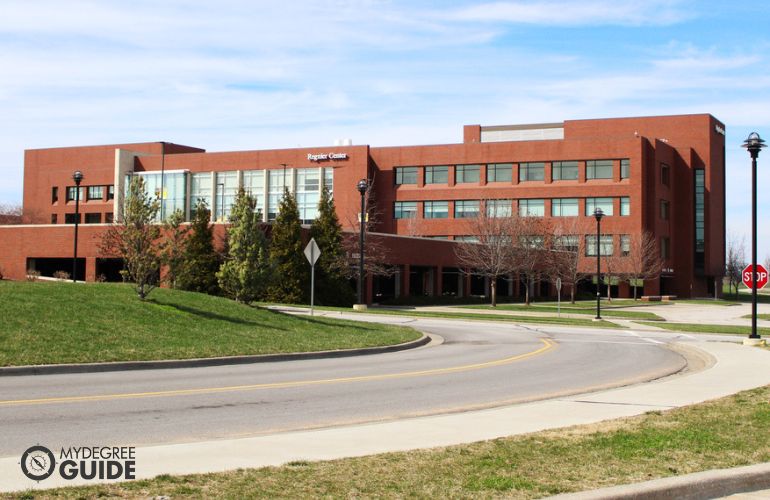
Regional accreditation is another factor to consider when choosing a school for your online physical therapy assistant program. Colleges and universities can earn accreditation if they meet extensive educational standards developed by external accrediting organizations.
Students at regionally accredited institutions receive a high-quality education, which can help them prepare for the PTA licensing exam. Additionally, the federal government only disburses financial aid to students in accredited programs.
You can visit the Council for Higher Education Accreditation’s website to learn more about regional accreditation.
CAPTE Accreditation
The Commission on Accreditation in Physical Therapy Education (CAPTE) sets the accrediting standards for physical therapy assistant programs in the United States.
CAPTE evaluates programs based on many criteria, including graduation rates, institutional policies, missions, and resources. Schools need to complete a self-evaluation and pass an on-site inspection by CAPTE staff to receive this programmatic accreditation.
Students must graduate from a CAPTE accredited PTA program in order to sit for the National Physical Therapy Examination and earn a state license to practice.
Physical Therapy Licensure and Certifications
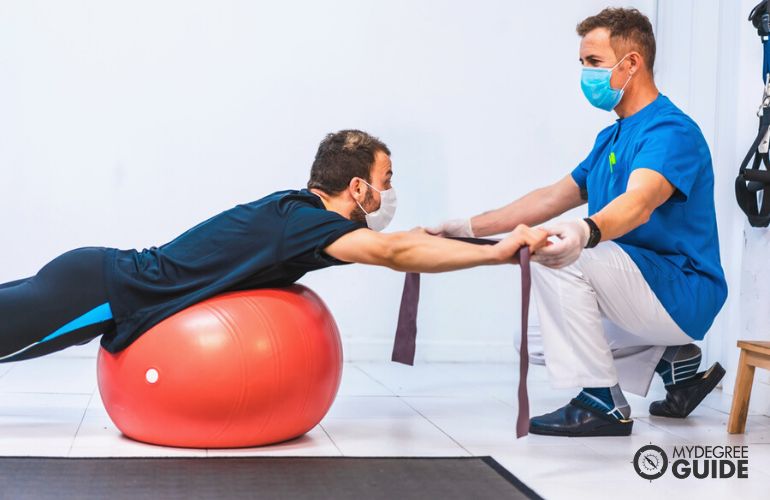
Every state requires physical therapist assistants to be licensed. Requirements vary by state, but all PTAs must pass the National Physical Therapy Exam. This test includes 200 questions that assess students’ knowledge of medical concepts and physical therapy practices.
PTAs can also boost their resumes by earning advanced certifications, such as:
- Advanced Cardiac Life Support Certification: This program trains PTAs and other healthcare providers to recognize and intervene in cardiac emergencies.
- PTA Advanced Proficiency Pathways: You can develop your expertise in an area of physical therapy, such as acute care, geriatrics, or wound management.
Certifications may help you secure a preferred position.
Financial Aid and Scholarships

Many students apply for financial aid to decrease their upfront educational costs. Some physical therapy assistant online programs offer grants and scholarships for eligible students. You may be required to complete a separate application to qualify for this assistance.
Additionally, the federal government provides financial aid for eligible students at accredited online schools. This aid can take the form of grants and work-study programs, which you don’t need to repay. You may also qualify for low-interest student loans. You can complete the Free Application for Federal Student Aid (FAFSA) to check your eligibility.
What Can You Do with a Physical Therapy Assistant Training?

Graduates who complete physical therapy assistant programs often pursue careers in the healthcare industry. Most become physical therapy assistants and help licensed physical therapists provide treatment for patients.
PTAs can work in numerous healthcare settings, including assisted living facilities, hospitals, and private physical therapy clinics. According to the Bureau of Labor Statistics, the demand for PTAs is expected to grow by 26% over the next ten years.
Some graduates pursue related careers in healthcare, like fitness trainer or pharmacy technician. Tech companies may also hire people with PTA training to help develop medical products.
What Does a Physical Therapist Assistant Do?

Physical therapy assistants collaborate with physical therapists to provide hands-on treatment for patients. They serve people with disabilities, health disorders, injuries, and other physical conditions.
Here are a few standard responsibilities of PTAs:
- Sanitize medical equipment and treatment areas
- Prepare therapeutic equipment, like exercise bands and medicine balls
- Collect data on patients and update medical records
- Help patients perform physical exercises
- Provide cold or hot therapy
- Educate patients and caretakers about treatment methods
- Follow up with patients after treatment
Depending on the employer, patient population, and physical therapist’s preferences, these duties can vary somewhat.
How Long Does It Take to Become a Physical Therapist Assistant?

People who want to learn how to become a physical therapist assistant often wonder how long it will take to complete their education.
Traditionally, most associate’s programs for PTAs take five semesters to complete. Full-time students typically finish these programs in 2 years or 2.5 years and may spend several months studying for the licensing exam. Some colleges and universities offer accelerated or hybrid programs that students can complete at their own pace.
Some students graduate from an accelerated program in as little as 12 months. Alternatively, you can enroll part-time and take longer to graduate if you have limited availability.
What’s the Difference Between a Physical Therapy Aide vs. Assistant?
Physical therapy aides and assistants work with physical therapists, but these positions differ in several ways.
| Physical Therapy Aide | Physical Therapy Assistant |
|
|
Physical therapy assistants tend to earn higher salaries than aides. Overall, physical therapist assistant requirements involve an associate-level education and licensure, whereas aides are not required to have a license or formal education.
What’s the Difference Between an Occupational Therapy vs. Physical Therapy Assistant?
Occupational therapy assistants and physical therapy assistants have distinct roles. Here are a few significant differences between these careers.
| Occupational Therapy Assistant | Physical Therapy Assistant |
|
|
If you’re interested in human anatomy and physical health, you may prefer a career as a physical therapy assistant.
Is a Physical Therapy Assistant Degree Worth It?
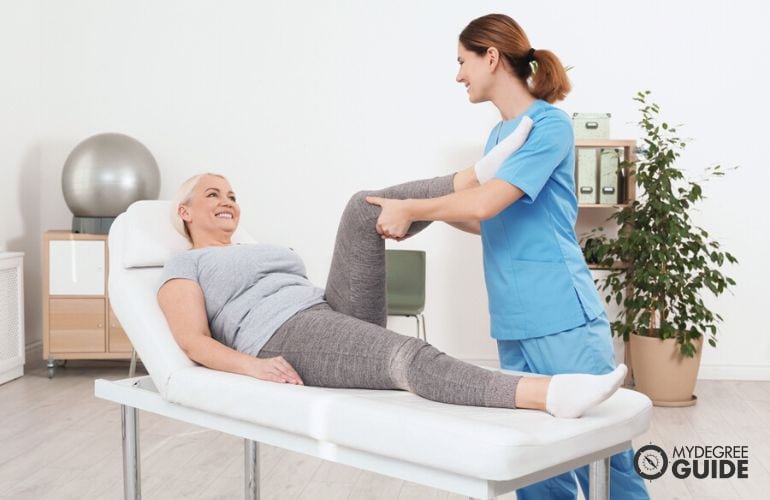
Yes, a physical therapy assistant degree is worth it for many students. This degree allows students to expand their knowledge of the human body and therapeutic practices. Students study practical topics like anatomy, kinesiology, and medical terminology.
Additionally, this degree enables students to gain hands-on experience in clinical settings. These learning opportunities help aspiring PTAs learn from more seasoned professionals, network, and develop interpersonal skills. Many graduates use their degrees to become licensed PTAs. They often secure positions with hospitals, skilled nursing facilities, and numerous other healthcare organizations.
Employment for physical therapy assistants is expected to grow by 26% over the next ten years, which is much faster than average (Bureau of Labor Statistics).
Getting Your Physical Therapy Assistant Degree Online

Physical therapy assistants can directly improve patients’ lives by helping them heal from physical injuries and surgeries. They provide hands-on treatment with therapeutic exercises, massage, and other methods.
People who enjoy interpersonal interaction and want to make a difference may find this career rewarding. An online physical therapy assistant degree can help you gain the knowledge and skills you need to work with physical therapists and patients. You’ll complete coursework and gain work experience through clinical practicum. After you complete your degree, you can sit for the national licensing exam.
You can start your educational journey today by researching accredited online physical therapy assistant programs.
